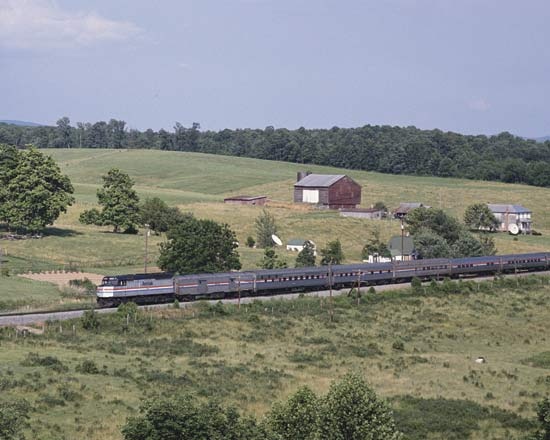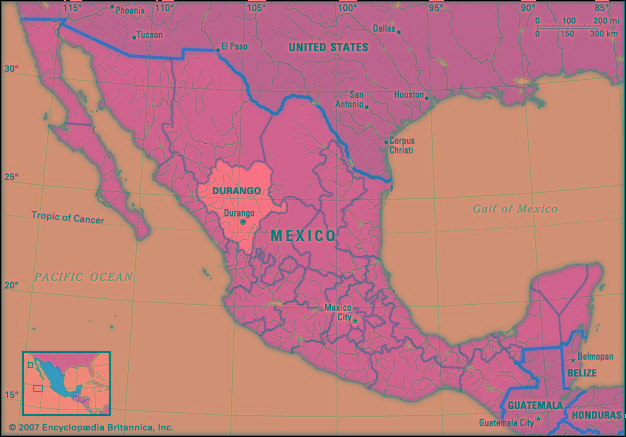Durango
Colorado, United States
 city, seat (1881) of La Plata county, southwestern Colorado, U.S., on the Animas River in the foothills of the La Plata Mountains at an elevation of 6,505 feet (1,983 metres). Founded in 1880 during a mining boom by the Denver and Rio Grande Western Railroad (Denver and Rio Grande Western Railroad Company), it was named for Durango, Mexico. It developed as a shipping point for farm produce (including livestock) and local natural resources (timber, coal, oil and gas, gold, silver, lead, uranium, vanadium). The city is also a tourist centre and the headquarters of the San Juan National Forest. The Durango & Silverton Narrow Gauge Railroad (1882; now used for sightseeing), Mesa Verde National Park, the Southern Ute Tourist Centre, the San Juan Skyway (a 236-mile 【380-km】 scenic road), and Purgatory Ski Area are local features of interest. Durango is the seat of Fort Lewis College (founded as a boarding school for American Indians in 1891 and given to Colorado by the federal government in 1911) and has some light manufacturing. Inc. 1881. Pop. (2000) 13,922; (2006 est.) 15,614.
city, seat (1881) of La Plata county, southwestern Colorado, U.S., on the Animas River in the foothills of the La Plata Mountains at an elevation of 6,505 feet (1,983 metres). Founded in 1880 during a mining boom by the Denver and Rio Grande Western Railroad (Denver and Rio Grande Western Railroad Company), it was named for Durango, Mexico. It developed as a shipping point for farm produce (including livestock) and local natural resources (timber, coal, oil and gas, gold, silver, lead, uranium, vanadium). The city is also a tourist centre and the headquarters of the San Juan National Forest. The Durango & Silverton Narrow Gauge Railroad (1882; now used for sightseeing), Mesa Verde National Park, the Southern Ute Tourist Centre, the San Juan Skyway (a 236-mile 【380-km】 scenic road), and Purgatory Ski Area are local features of interest. Durango is the seat of Fort Lewis College (founded as a boarding school for American Indians in 1891 and given to Colorado by the federal government in 1911) and has some light manufacturing. Inc. 1881. Pop. (2000) 13,922; (2006 est.) 15,614.Mexico
in full Durango de Victoria
city, capital of Durango estado (state), north-central Mexico. It lies in the south-central part of the state in a fertile valley of the Sierra Madre Occidental, about 6,200 feet (1,900 metres) above sea level.
Although first settled in 1556, Durango was not officially founded until 1563. It was the political and ecclesiastical capital of Nueva Vizcaya, which included Durango and Chihuahua until 1823. Since colonial times the city has been known as a health resort because of nearby hot springs. Durango's economy is now based on a mixture of services (including commerce, transport, government, and education) and manufacturing (notably steel goods, clothing and accessories, motor vehicle parts, and paper products). Its agricultural hinterland is largely dedicated to beef cattle, vineries, and cereal crops. The city is also a mining centre owing to the exploitation of one of the world's largest deposits of iron ore at Mercado Hill, just to the north. Durango, the site of the Juárez University of Durango (1957), is a regional transportation hub, easily accessible by a nearby international airport and by highway and railroad. Pop. (2000) city, 427,135.
state, Mexico
 estado (state), north-central Mexico. It is bounded by the states of Chihuahua to the north, Coahuila and Zacatecas to the east, Jalisco and Nayarit to the south, and Sinaloa to the west. The state capital is the city of Durango (Durango de Victoria).
estado (state), north-central Mexico. It is bounded by the states of Chihuahua to the north, Coahuila and Zacatecas to the east, Jalisco and Nayarit to the south, and Sinaloa to the west. The state capital is the city of Durango (Durango de Victoria).The western portion of the state's territory lies within the mineral-laden Sierra Madre Occidental. Semiarid plains, which support ranching, make up the eastern portion. Coursing eastward from the Sierra Madre is the Nazas River, the largest river in the state. It flows for approximately 375 miles (600 km); when swollen by spring rains, it is the main source of water for irrigated crops of cotton, wheat, corn (maize), tobacco, sugarcane, vegetables, and fruits.
The state's temperate coniferous forests are the site of logging operations and pulp mills. Although mining has been carried on for years, the deposits of silver, gold, sulfur, tin, coal, mercury, copper, and other minerals have been only partially exploited. Mercado Hill, about 700 feet (210 metres) high and consisting of nearly pure hematite iron ore, is adjacent to Durango city. A silver mine near San Dimas has long been renowned for its output. Other mining districts are Mapimí, Cuencamé, Nombre de Dios, Papasquiaro, and San Juan del Río. The state's scenic areas include waterfalls and hot springs at La Joya and San Juan and the protected forests and wetlands of the Santiaguillo Lagoon, near Durango city.
First explored by Europeans in 1562–63, Durango shared the colonial history of Chihuahua as a major part of the province of Nueva Vizcaya; the two became sovereign and separate states in 1823. Native American peoples rebelled often in their frontier areas during the 19th century. In the late 20th century Durango became part of the so-called “hollow core” of Mexico as increasing numbers of migrants left to seek jobs in Mexico City, along the U.S.-Mexican border, or within the United States.
State government is headed by a governor, who is elected to a single six-year term. Members of the legislature (the unicameral House of Deputies) are elected to terms of three years. The legislature can levy taxes, but in reality Durango depends on the federal government for most of its revenue. Like other Mexican states, Durango is divided into local governmental units called municipios (municipalities), each of which may include a city or town and its hinterland or, alternatively, a group of villages.
Railroads traverse the state northeast to southwest, and another line crosses its eastern section. Durango is also crossed by two branches of the Pan-American Highway and has air connections. Area 47,560 square miles (123,181 square km). Pop. (2000) 1,448,661; (2005) 1,509,117.
- Prince Orlov, Aleksey Fyodorovich
- Prince Patrick Island
- Prince Paul Karadjordjević
- Prince Phetsarath Ratanavongsa
- princeps
- Prince Repnin, Nikolay Vasilyevich
- Prince Rupert
- Prince Rupert
- Princess Charlotte Bay
- Princess de Lamballe, Marie-Thérèse-Louise de Savoie-Carignan
- princesse des Ursins, Marie-Anne de la Trémoille
- princess of Belgium Mathilde
- princess of Wales Diana
- princess style
- Princeton
- Princeton University
- Prince von Auersperg, Johann Weikhart
- Prince Von Wahlstatt Blücher, Gebhard Leberecht von
- Prince Vorontsov, Mikhail Semyonovich
- Prince William of Wales
- Prince William Sound
- Prince zu Schwarzenberg, Felix
- Prince zu Schwarzenberg, Karl Philipp
- Prince zu Thun und Hohenstein, Franz Anton
- Principal constituents of seawater*